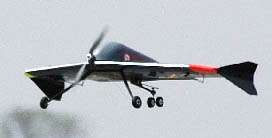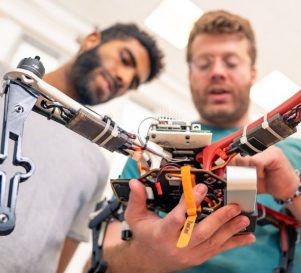Albatross: Flying Wing Small UAV
- A. Volovick, J. Matsibeker, A. Zeisel, N. hellman, S. Elbaz, A. Gat, D. Abramov, G. Stafora, M. Baruch, Y. Cohen, A. Wolf, H. Levy, E. Raviv, A. Wieder
- Shlomo Tsach

The team participated in the Design-Build-Fly (DBF) competition, organized by AIAA which took place at Webster Field, St. Inigos, MD, USA. They were required to build an all-electric airplane capable of carrying two payloads, on its wing tips and inside the fuselage (2 configurations). The airplane had to be packed into a 2x1x4 ft box after every mission. The team designed a small flying wing, which fitted into the box without being disassembled. Apart from the configurations, it had to perform 2 out 3 given missions:
- Sensor reposition – the aircraft had to carry two external payloads and perform three laps as follows: fly the first lap and after landing remotely deploy one payload at each of two separate release locations. Fly a second laphy and after landing taxi to a specified reload station near the first release location. The tem then reloads one of the payloads, and the aircraft taxis to the second reload station where the team repeats the payload reloading process. Finally, the aircraft performs a final lap and comes to a complete stop after landing.
- Maximum utilization – includes two internal payloads. The aircraft flies as many laps as the team deems possible. On landing, the aircraft crosses the takeoff start line and comes to a complete stop.
- Re-supply – included two internal payloads. The aircraft performs four laps as follows: the aircraft takes off and flies one lap with an internal payload. On landing, the aircraft crosses the takeoff start lines and comes to a complete stop, and the ground crew then removes the payload. The aircraft takes off again and flies a second lap and lands once again. The ground crew then reinstalls the payload and the aircraft flies a third lap. After landing, when instructed by the flight line judge, the ground crew removes the payload. Finally, the aircraft flies a fourth lap and lands.
Each lap must include one complete 360 degree turn. At the end of each mission the aircraft is returned to the storage box.
Aerodynamic Design
The final configuration was chosen according to Rated Aircraft Cost (RAC) as well as aerodynamic considerations (flying wing with small AR has poor longitudinal stability, due to the lack of the horizontal tail, and poor directional stability due to the lack of the vertical tail). Another problem is that very little is known about flying-wing behavior and full state equations do not exist, thus all analyses of the flying-wings made in the past are trial and error, which means that past experience can only give tips, but not equations for exact calculations. In this case, the wing has a very low aspect ratio (2.68), in order to fit into the specified container without being disassembled. This means that only rough calculations could be made, and some aerodynamic improvements would have to be applied after initial flight tests. The aircraft is controlled by 2 Elevons (elevator + ailerons) and the engines RPM. When the Elevons move in opposite directions – Roll-Moment is generated (aileron effect) and when the Elevons move in the same direction – Pitch-Moment is generated (elevator effect). In order to increae the pitch effectiveness of the Elevons, the wing has a sweep back of 16 (storage limitations).
Competition
First flight: Max Utilization Mission – flight score was 3.0. Second flight: Re-supply Mission – flight score was 84.2. Third flight: tried to improve on the second flight, but the battery stack began to lose its power due to unbalanced charged batteries between left and right package. Fourth flight: Sensor Reposition Mission – Th day before, the propeller was changed to a smaller size. The aircraft climbed into the air, but was not powerful enough and the mission was aborted. Fifth (last) flight: tried to improve on the fourth flight. The original propeller was reinstalled, but on the last lap a malfunction in the payload release mechanism occurred and the mission failed.
The team was placed 10th out of 49 teams, who performed in the competition and 66 who were assigned.








